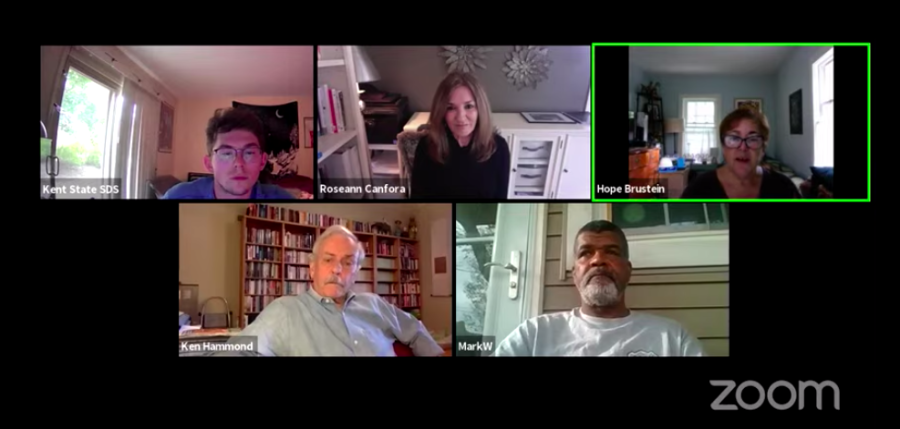May 4 anniversary sparks discussions on Tent City protests
The Tent City panel on Sunday talked about what it was like living on Blanket Hill during the protest. Pictured, top from left to right: Bryce Schlenker, Chic Canfora, Hope Brustein. Bottom, left to right: Ken Hammond, Mark Webster.
May 3, 2021
Students for a Democratic Society brought together a panel on Sunday of former Kent State students who protested the Vietnam War and the building of the gym annex by the university over the site of May 4. The panel featured activists from the original May 4 protests and the subsequent Tent City protest of 1977, Hope Brustein, Chic Canfora, Ken Hammond and Mark Webster, led by SDS co-chair Bryce Schlenker.
“All issues of 1970 are still issues today. In some cases, they’ve gotten worse,” Colt Hutchinson said. Hutchinson is the chair of SDS and held a key role in organizing this weekend’s events.
The panel discussed the events of the protest between themselves before the meeting was opened to questions. Some questions were prepared by students from SDS; others were posed by the audience.
When asked about the composition of the protest the panel responded with laughter at first. “There were a lot of us, and we all had differences of opinion,” Hammond said. Hammond also described the environment of the tent city as a “collective,” mentioning they had a chores chart, and every student shared the burden of the protest.
Canfora took a question about spreading their message when the university was against them and related it back to a comment comparing the SDS organization today to the organization in 1977. “I don’t think we were allowed either, but we just did it. We were sliding them (flyers) under dorm room doors. We were hanging them up in the Student Center. We handed them out everywhere.”
Activism at Kent State during the 1970s took more forms than mass flyer handouts. Students and protesters put their physical safety on the line as well.
“When they put up a fence, we took it down. When they put up another fence, we took it down again,” Canfora said. The fences belonged to the university as they were erected around the future site of the gym annex. Weeks of protesting ended with the gym being built, but not before protesters threw themselves into the holes being dug by the bulldozers.
Aside from chants, numbers and their community, the protesters had other tools at their disposal. “How we present ourselves to the other side as real human people is one of our strongest weapons,” Webster said.
The Tent City protest lasted two months and was held together through community and force of will. The group was organized. They had a food tent to feed the protesters and had lists of chores for protesters so the tent city could continue. Some protesters like Brustein, Webster, Hammond, Canfora and her brother, Alan, were arrested in July 1977 as the tent city was cleared by unarmed Kent State police officers. Key figures to the protest gave up financial resources to the cause and even their freedom for a time.
“There were these passionate people, like Alan, that inspired us,” Webster said. Webster was only in junior high when the May 4 shootings happened in 1970 but was a student during the Tent City protests. He cited Chic and Alan Canfora as a reason he got involved.
The event held by SDS was held virtually as part of the organization’s attempt to memorialize May 4 as a student organization. The event was dedicated to Alan Canfora, who was a monumental component of the May 4 protests and the fight to memorialize the tragedy in the 50 years since the shootings. Alan passed away in December 2020.
Blake Westover is the politics reporter. Contact him at [email protected].












